Features of proper care for calla lilies

Calla is one of those plants that have a unique flower shape. Belongs to the type of angiosperms of the dicotyledonous class. They are an indoor and garden plant, and are used for decorative purposes to give the interior a unique style and when composing various flower arrangements.
There are a variety of shapes and colors, depending on the type of selection. The flowers are located on long roots. The lower leaves are quite close to the root. The inflorescence itself is located on the area of the stem where there are no leaves. The color range of plants is quite diverse - red, blue, pink, purple, yellow. The bract is surrounded by a funnel-shaped blanket. The leaves are massive and can reach a length of up to 15 centimeters and a width of up to 11 centimeters, and have a bright green color.
Content:
- Features of caring for callas in the garden
- Features of caring for callas in pots
- Features of growing calla lilies from seeds and seedlings
Features of caring for callas in the garden
The courtship process requires the competent implementation of the following points:
- Landing
- Watering
- Fertilizer
- Transfer
- Reproduction
In order for a plant to please the eye for a long time, it needs proper care. Basically, the plant is distinguished by its tolerance to changing weather conditions, however, it requires a careful approach to the choice of soil composition. The soil should be acidic.
It is optimal if it contains peat, turf soil, compost, and sand.It is also necessary to carefully monitor the watering process. The plant came to us from a swampy area, so it needs constant soil moisture. If the soil is dry, this will cause the plant's leaves to begin to turn yellow. It is especially recommended to water frequently on hot days. If frequent watering is not possible, then it is advisable to plant the plant near water bodies. However, this does not apply to artificial ponds because they have no contact with the ground.
Growing process Calla lilies should be accompanied by regular feeding. As a rule, fertilizing is carried out once a year. But, if the plant has stopped blooming, then it is necessary to feed the plant much more often. For regular flowering of plants in garden conditions, it is necessary to supply the plant with nutrients twice a month. During irrigation, liquid fertilizers and compost are added to the water.
You should carefully monitor the condition of the plant to avoid overfeeding. Overfeeding is indicated by scorched leaves due to the high nitrogen content. In order for a plant to bloom regularly, it must receive enough sunlight. If there is not enough ultraviolet radiation, then it is necessary to increase the dose of fertilizing. Callas appreciate open areas, as there is more room for growth.
Features of caring for callas in pots
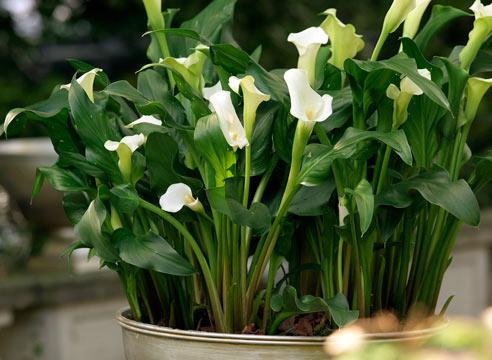
A plant that kept in pots, requires a different approach to care. The plant needs more frequent watering, since a different indicator of air humidity prevails in the room. In addition, a significant amount of moisture is lost in the pot. The power system is also somewhat different.
The plant must be replanted annually in new soil, since the soil tends to accumulate excess fertilizer, creating an unfavorable environment, and the plant may die. An increase in the toxicity level of the fertilizer causes the shoots to become thin.
Calla lilies are planted using bulbs:
- This bulb looks like a small shoot of a root.
- Shoots subsequently begin to grow from the bulb.
- The bulb begins to germinate after it receives the required amount of water and nutrients.
- The plant spreads due to the increase in the number of rhizomes.
The planting procedure is simple. For planting, it is necessary to use well-drained soil, otherwise the plant may begin to rot. When planting more than one bulb, a distance of twelve centimeters must be maintained so that the plant can grow unhindered.
In order for the plant to take off well in the early stages of growth, it is recommended to water it more often. The plant loves wet soilIf there is not enough moisture, growth and flowering stops. Over time, the rhizome will produce other bulbs, which must be dug up for the purpose of replanting or eradicating.
Features of growing calla lilies from seeds and seedlings
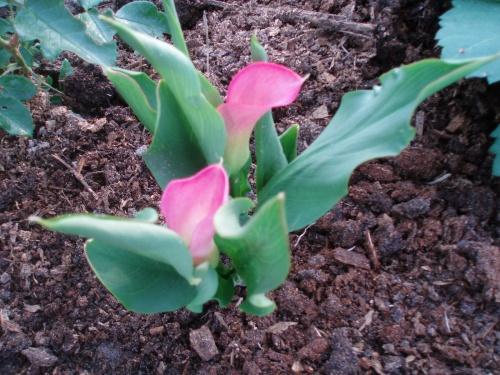
In addition to propagation by bulbs, calla lilies can be propagated using seeds. Seeds can be purchased at the store. It is more economical to wait for the seed pods of friends to ripen. From seeds, the germination period is quite long and requires careful temperature control.
Before planting, the seeds must be germinated by placing them in a moist environment.To do this, you need to use a paper towel on which the seeds are placed. Next, the seeds must be covered on top with the same damp paper towel and placed on a small plate in a dark, cool place. The towel should be slightly wet, as excess moisture can cause the plant to rot.
It is not recommended to plant seeds directly in the garden, as the chance that they will germinate there is reduced. A large number of microorganisms live in garden soil, and they are not immune from bird attacks. It is recommended to sow seeds in a small pot where all the necessary conditions for their healthy germination are created.
Can be purchased special land for plants of this type, which contains the optimal ratio of nutrients. At the time of germination, there is a high risk of seed rotting, so watering should be carried out regularly and in small quantities. It is better to supply the seeds with moisture through the bottom of the pot. There should be no more than two seeds in one pot at a time.
Once the callas have reached the desired size, they can be transplanted into open ground or a pot of the appropriate size. In order for a plant to bloom and delight with its healthy appearance, it must be adapted to new conditions. Before transplanting, it is recommended to wash the roots. This procedure must be performed carefully so as not to damage the root system and introduce bacteria and other microorganisms.
The process of propagating calla lilies by seeds is quite fascinating, since the final result remains unknown. Calla lilies, which are grown from seeds, rarely resemble their parents. As a result, you can get an interesting color scheme for the plant.
The subtleties of growing calla lilies on video:
Interesting information about the vegetable garden



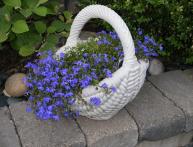

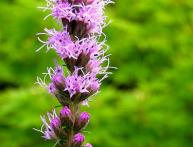
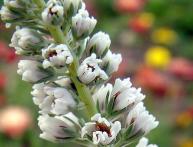



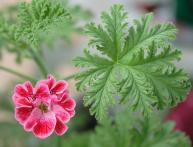
Comments
For me, calla lilies are forever associated with childhood - my school friend’s mother loved them very much and grew them at home. It was very surprising. after all, there was no such abundance of exotic green pets back then.